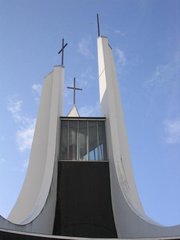Spire
|
|

A spire is a tapering conical or pyramidal structure on the top of a building, particularly a church tower. Etymologically, the word is derived from Anglo-Saxon, so it is related to "spear," rather than the Romance languages and "spirit."
Symbolically, spires have two functions. The first is to proclaim a martial power. A spire, with its reminiscence of the spear point, gives the impression of strength. The second is to reach up toward the skies. The celestial and hopeful gesture of the spire is one reason for its association with religious buildings.
As an architectural ornament, spires are most consistently found on Christian churches, where they replace the steeple. Although any denomination may choose to use a spire instead of a steeple, the lack of a cross on the structure is more common in Roman Catholic and other pre-Reformation churches. (Note, in the photo at right, that the spire serves as a platform for three bare crosses in imitation of Calvary, marking the center as Protestant (Anglican).) The battlements of cathedrals featured multiple spires in the Gothic style (in imitation of the secular military fortress).
St-andreas.jpg
Spires are also common and notable as solo structures. After contact with Egyptian architecture and the mania for Egyptian artifacts in the west in the 19th century, towers in the shape of obelisks enjoyed a vogue. When original obelisks could be imported, such as Cleopatra's needle in New York City, they were, but spires as memorial structures were popular in funerary architecture and public monuments (e.g. the Washington monument in Washington, DC) into the 20th century. In the Modernist movements of the 20th century, office towers in the form of free-standing spires also began to be built. Some famous buildings, such as the Space Needle in Seattle, Washington, use the spire as a testimony of civic power and hope; in the case of this example, it is also a reference to Seattle's participation in aerospace. A 1,776-foot tall (541 m) "Freedom Tower" is a projected feature of the 9/11 Memorial in New York City, and is to be topped by a spire.
Of course, the philosophy behind a spire on one side of the Atlantic can be quite different from the interpretation in Europe. In Europe a spire on a church or cathedral is not just a symbol of piety, but cynically, also a symbol of the wealth and prestige of the order, or patron who commissioned the building.
Whatever the reason for their erection, spires were an astounding architectural phenomena during the medieval gothic period of architecture. Since that time nearly 700 years ago they have never really fallen out of fashion.
In England, "spire" immediately brings to mind Salisbury Cathedral. Its 123-meter (403-foot) spire, built between 1320 and 1380, is the tallest of the period anywhere in the world, and in its way is as remarkable as the Coliseum in Rome or the parthenon in Athens. A similar but slightly smaller spire was built at Leighton Buzzard in Bedfordshire, England, which indicates the popularity of the spire spreading across the country during this period. We will never know the true popularity of the medieval spire, as many more collapsed within a few years of building than ever survived to be recorded. In the United Kingdom spires generally tend to be reserved for ecclesiastical building, with the exception to this rule being the spire at Burghley House, built for Elizabeth I's Lord Chancellor in 1585.
In the early Renaissance the spire was not restricted to the United Kingdom: the fashion spread across Europe. In Antwerp the 123-meter spire was the tallest structure in the low countries for over five centuries. Between 1221 and 1457 richly decorated open spires were built for the Cathedral of Burgos in Spain, while at Ulm Cathedral in Germany the 529-foot (161-meter) spire was built in the imported French Gothic style between 1377 and 1417.
Interestingly, the Italians never really embraced the spire as an architectural feature, preferring the classical styles. The gothic style was a feature of Germanic northern Europe and was never to the Italien taste, and the few gothic buildings in Italy always seem incongruous. That is not to say that no one ever attempted to blend the classical styles with a spire, but this occurred much later. In 1822, in London, John Nash built 'All Souls' Church Langham Place, a circular classical temple, with Ionic columns surmounted by a spire supported by Corinthian columns. Whether this is a happy marriage of styles or a rough admixture is a question of individual taste.

During the 19th century the Gothic revival knew no bounds. With advances in technology, steel production, and building techniques the spire enjoyed an unprecedented surge through architecture, Cologne Cathedral's famous spires, designed centuries earlier, where finally completed in this era.
Later in the 19th century, Art Nouveau produced the most bizarre effects when incorporated into ecclesiastical architecture. It reached its most exaggerated point in the phenomenal spires of Sagrada Familia in Barcelona. Designed and begun by Antoni Gaudi in 1884, they were not completed until the 20th century. A cross between a stalagmite and a melting wedding cake, they cannot fail to amaze.
As described earlier, the spire as an architectural form has continued to metamorphose and develop into more modern and even more fantastic forms, which in turn have inspired such sculptures the Spire of Dublin) throughout the 20th century, and will undoubtedly continue to do so in the 21st century.
